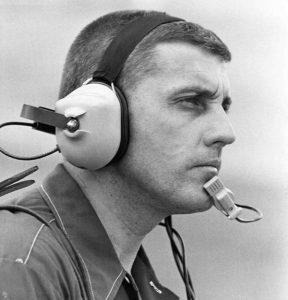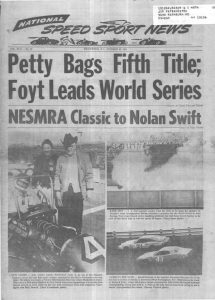Editor’s Note: NASCAR is celebrating its 75th anniversary in 2023. SPEED SPORT was founded in 1934 and was already on its way to becoming America’s Motorsports Authority when NASCAR was formed. As a result, we will bring you Part 27of a 75-part series on the history of NASCAR as told in the pages of National Speed Sport News and SPEED SPORT Magazine.
The 1974 NASCAR Winston Cup season can be summed up thusly: “(Pocono lnt’l Raceway’s Purolator 500) was a highly competitive race with 19 lead changes among five drivers,” read the Aug. 7 National Speed Sport News. “The four which have won all 20 NASCAR Winston Cup races to date: (Richard) Petty, (David) Pearson, (Cale) Yarborough and (Bobby) Allison, plus Buddy Baker dominated. No one else had a chance.”
The 30-race season amounted to a five-driver year led by Petty and Yarborough. Everyone else was lapped traffic.
Yarborough started the season with his first victory on the 2.62-mile Riverside Int’l Raceway road course. He pushed his Chevrolet Chevelle Malibu to the limit and ran out of gas before he completed his victory lap. Petty was second and Pearson third.
Four-time champion Petty garnered a record fifth Daytona 500 triumph on Feb. 17. Due to the OPEC oil embargo, NASCAR’s marquee event and all subsequent races were shortened by 10 percent in accordance with an agreement with the Federal Energy Office and major race sanctioning bodies.
So when race leader Petty blew his left front tire on the 160th lap, he had 20 fewer 2.5-mile circuits than usual to make up the 38-second lead Donnie Allison had built. Yet, when the checkers waved after the 60th lead change, the STP-sponsored car was under the flag first, ahead of Yarborough’s No. 11 ride.
From Daytona Beach, Fla., the teams traveled north to Richmond (Va.) Raceway. Petty looked like he was going to claim his second triumph in a row, but a pit miscue allowed Bobby Allison to grab a three-second victory over Petty and Yarborough.
Petty added North Carolina Motor Speedway’s Carolina 500 to his résumé with a record 122.622 mph average speed, but it was his last victory for seven weeks, allowing Yarborough to grab the point lead.
Restrictor Plates Removed, Rule Changes Imminent
The Petty Enterprises team, led by Maurice Petty and Dale Inman, realized the truth about their Chrysler 426-cubic-inch “hemi-head” engine: The engine design they had used since the 1960s was no longer competitive with the small-block engines most teams now used.
While restrictor plates were done away with in March, a new NASCAR issued Holley carburetor greatly restricted fuel flow to engines over 367 c.i. beginning with the April 28 event at Martinsville (Va.) Speedway.

With this rule change imminent and NASCAR frowning on continued usage of the non-production big-block V-8s, the Petty team went to work on a 362 c.i. engine only one month before the Martinsville race. Under the direction of chief builder Maurice Petty, the small-block: was ready a week ahead of schedule.
One of Petty’s favorite tracks, North Wilkesboro (N.C.) Speedway, hosted its 13th annual race on April 21. The 37-year-old pilot left no doubt about his driving talent nor the ability of his brother Maurice and to construct a winning powerplant. Petty bested Yarborough by two laps for his seventh victory in this race, while regaining the point lead.
“The little engine is about 200 pounds lighter and we were able to move weight to the rear wheels for better traction and handling,” Richard Petty explained. “I feel better about our chances for the rest of the season.”
Not everyone was so taken by the small blocks, which were mandated for 1975 to measure 358 c.i. After David Pearson’s victory at Talladega (Ala.) Superspeedway, team owner Glen Wood complained, “It isn’t as reliable (as the big block: engines) … There’s a continuing problem of cracks in the cylinder walls, and we sit there the whole race wondering if it’s going to last all the way.”
Wood’s criticism joined the Junior Johnson and Harry Hyde chorus of complaints about the change from large to small engines.
Hyde was most upset about the carburetors: “The carbs NASCAR and Holley carbs are preparing for us are not muscle car items by any means. They’re discarded castings from an International Harvester truck motor that should be used for hauling corn on an Iowa farm with a NASCAR official driving it instead of mounted on a sophisticated car in a sophisticated race on a sophisticated speedway with a sophisticated driver.”
Small Block vs. Big Block
NASCAR responded with carburetor tests at Talladega in May to “equalize” the big- and small-blocks.
Johnson and Hyde, who managed the Nord Krauskopl-owned K&K Insurance team, participated, but NASCAR increased the fuel flow by only 20 cubic feet per minute, from 370 to 390, far short of the 600-700 cfm which Johnson desired for his Yarborough-driven big-block Chevrolet and far below the 1,100 cfm which the small blocks received.
“NASCAR is slam crazy if it thinks the new rule will help us more than 25 horsepower,” Johnson commented. “That leaves us 100 horsepower short.”
Even the reticent Lee Petty added, “We haven’t had a chance since NASCAR slapped the smaller carb on the (426) hemi.”
Yet, big-block devotees, notably Yarborough and Petty, were not about to abandon the engines which had brought them so much success. Petty started 23rd at Talladega, but ascended to third at the finish because his Chrysler 426 was more fuel-efficient than the smaller engines. In the same event, Yarborough finished ninth in his Chevelle, but secured the first leg of the Winston Cup season and $10,000 for his accomplishment.
Petty won the Music City 420 in Nashville, Tenn., for the eighth time in 10 years before adding a Michigan Int’l Speedway victory in June. Career victory No. 160 came at Atlanta on a 100-degree July day.
The following week, Petty served as best man for the STP-sponsored wedding of his fan club president, David Carter, at Pennsylvania’s Pocono Raceway. After the nuptials, Petty won the first Cup Series race on the 2.5-mile triangular track. He also won for the first time at Talladega in a door-to-door finish with Pearson on Aug. 11.
Meanwhile, Yarborough extended his point lead with a June victory at Dover (Del.) Int’l Speedway.
His sixth victory of the season came three weeks later at Riverside.
Behind-The-Scenes Of Yarborough’s Season
Behind the scenes, Yarborough’s team was running out of money, which is why the Junior Johnson/Ricbard Howard-owned team was sold to the Carling Brewing Company in June.
The new owner replaced financially-troubled Kar-Kare Company and promised to invest $250,000 into the team in 1974 and $500,000 next season. Carling also agreed to pay $10,000 to the top rookie in the new rookie point system. Eventual rookie-of-the-year and the only driver outside of the top four to win a race this season, Earl Ross, became Yarborough’s teammate.

Yarborough won at Bristol (Tenn.) Motor Speedway after colliding with Buddy Baker on the final lap. The driver of the No. 11 Carling Black Label Beer car recovered first and led Baker and Petty across the stripe.
One week later, the point leader won at Nashville’s Fairgrounds Speedway.
While Yarborough and his support team were financially secure with a major sponsor, many independent drivers were barely hanging on. For instance, Cecil Gordon wrecked at North Wilkesboro and the damage to his car cost $1,000 to repair, but he only won $380.
Without a major sponsor, even competitive independent drivers such as James Hylton, who had finished in the top four in points seven of the last eight seasons, estimated his losses for 1974 to be upward of $30,000.
This is a major reason why STP-sponsored Richard Petty led the Carling Black Label Beer-sponsored Cale Yarborough, the Purolator-aided David Pearson, K&K Insurance-supported Buddy Baker and the Coca-Cola car driven by Bobby Allison at the top of the victory column.
As the Winston Cup Tour ventured to Darlington (S.C.) Raceway for the Southern 500 in September, Petty held a 500-point advantage over Yarborough with eight races remaining. Yarborough survived 11 caution flags, which led to the slowest Southern 500 since 1964, and won for a record-tying third time on Labor Day.
But Yarborough won only one more time the remainder of the season, while Petty won at Richmond and Dover and added a pair of second-place finishes during the final eight races to earn his fifth Cup Series title.
Yarborough ended a strong season with 10 victories and was second in the points while third-place Pearson won seven times while starting from the pole on 11 occasions.
In other NASCAR divisions, Ray Elder’s five victories propelled him to the Grand National West title and Joey Kouralas was the Northern NASCAR champion.
